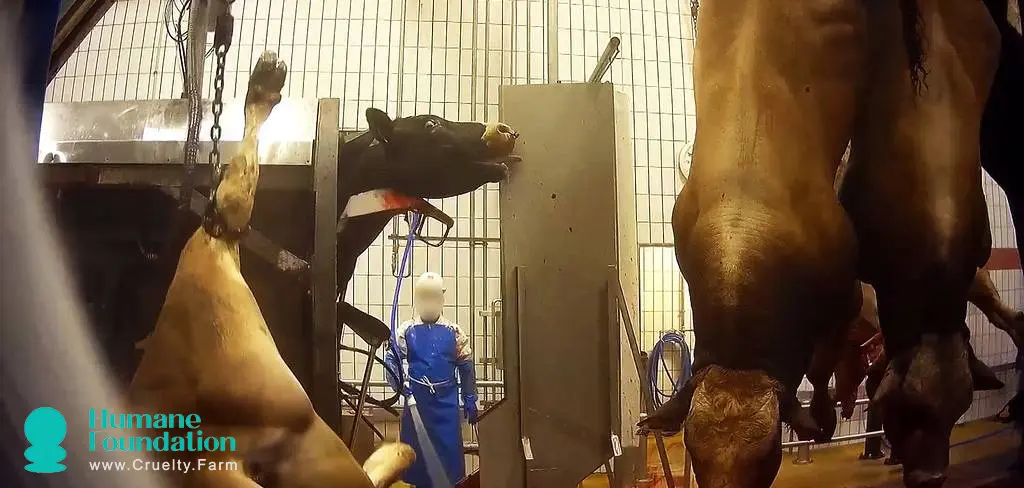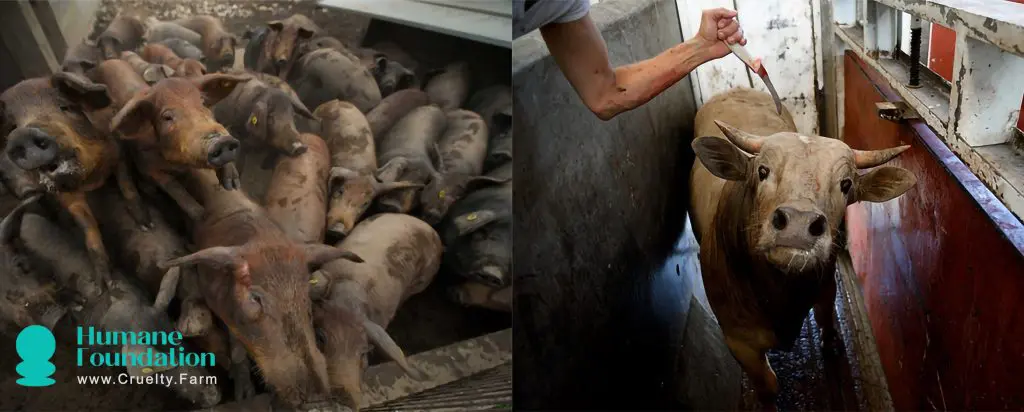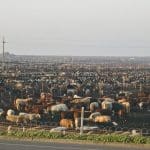Behind the carefully curated facade of the meat industry lies a hidden reality of profound animal suffering. Slaughterhouses, operating far from public scrutiny, serve as stark reminders of the ethical cost of industrialised animal agriculture. Within their walls, sentient beings endure overcrowding, fear, and often brutal handling in an unrelenting pursuit of efficiency. This article uncovers the distressing conditions animals face before and during slaughter while examining the broader implications for animal welfare, environmental sustainability, and human health. By confronting these concealed cruelties, we invite reflection on how transparency and reform can pave the way towards a more compassionate future
Introduction
Behind the innocuous façade of the meat industry lies a grim reality that often escapes public scrutiny – the immense suffering of animals in slaughterhouses. Despite the veil of secrecy that shrouds these facilities, investigations and whistleblowers have shed light on the harrowing conditions endured by animals destined for our plates. This essay explores the hidden world of slaughterhouses, delving into the ethical implications of industrialized animal agriculture and the urgent need for transparency and reform.

The Industrialization of Animal Agriculture
The rise of industrialized animal agriculture has transformed the process of meat production into a highly mechanized and efficient system. However, this efficiency often comes at the cost of animal welfare. Slaughterhouses, the final destination for millions of animals, operate on a massive scale to meet the demands of global meat consumption. In these facilities, animals are treated as commodities, subjected to harsh conditions and relentless processing lines.
Suffering Behind Closed Doors
In the heart of industrialized animal agriculture, behind the imposing doors of slaughterhouses, a hidden world of suffering unfolds daily. Shielded from public view, the grim reality of what happens within these facilities reveals a stark contrast to the sanitized image of meat production presented to consumers. This essay delves into the depths of this hidden suffering, exploring the experiences of animals subjected to the brutal processes of modern slaughterhouses.
From the moment animals arrive at slaughterhouses, fear and confusion grip them. Separated from their familiar environments and herds, they are ushered into a realm of chaos and terror. Crowded pens, deafening machinery, and the scent of blood hang heavy in the air, creating an atmosphere of relentless anxiety. For prey animals like cattle, pigs, and sheep, the presence of predators—human workers—heightens their instinctual fear, amplifying their distress.

Once inside, animals are subjected to a series of harrowing procedures. Cattle, often prodded and pushed by workers wielding electric prods, shuffle towards their fate. Pigs, squealing in panic, are herded into stunning pens where they are meant to be rendered unconscious before slaughter. However, the stunning process is not always effective, leaving some animals conscious and aware as they are shackled and hoisted onto conveyor belts.
The speed and volume of production in slaughterhouses leave little room for compassion or consideration of animal welfare. Workers, pressured to maintain an unyielding pace, often resort to rough handling and careless practices. Animals may be roughly grabbed, kicked, or dragged, resulting in injuries and trauma. Amidst the chaos, accidents are common, with animals sometimes falling onto the killing floor while still conscious, their screams drowned out by the relentless din of machinery.
Even in death, the suffering of animals in slaughterhouses knows no end. Despite efforts to ensure a swift and painless demise, the reality is often far from humane. Improper stunning techniques, mechanical failures, and human error can prolong the agony of animals, condemning them to a slow and agonizing death. For sentient beings capable of experiencing pain and fear, the horrors of the slaughterhouse represent a betrayal of their most basic rights and dignity.

The suffering of animals in slaughterhouses is not confined to the walls of these facilities but reverberates throughout our society. The consumption of meat produced under such conditions perpetuates a cycle of cruelty and indifference, normalizing the exploitation and commodification of living beings. Moreover, the environmental and health consequences of industrialized animal agriculture—such as deforestation, water pollution, and the spread of zoonotic diseases—pose significant risks to both animals and humans alike.
Addressing the suffering behind closed doors in slaughterhouses requires a collective reckoning with the ethical implications of our food choices. By demanding transparency, accountability, and reform within the meat industry, we can strive towards a more compassionate and sustainable future for animals and ourselves. It is only by confronting the hidden horrors of slaughterhouses that we can begin to build a world where cruelty has no place and where the dignity and welfare of all living beings are valued and respected.
The Ethical Imperative
The widespread suffering of animals in slaughterhouses raises profound ethical questions about the morality of industrialized animal agriculture. As sentient beings capable of experiencing pain and suffering, animals deserve to be treated with compassion and respect. However, the current system prioritizes profit and efficiency over animal welfare, resulting in widespread abuse and cruelty.
Furthermore, the environmental and health consequences of industrialized animal agriculture cannot be ignored. The intensive use of resources, including land, water, and feed, contributes to deforestation, water pollution, and greenhouse gas emissions. Additionally, the consumption of meat produced in unsanitary and inhumane conditions poses risks to human health, including the spread of diseases and antibiotic resistance.
The Call for Transparency and Reform
The hidden suffering of animals in slaughterhouses demands urgent action. Transparency is essential to hold the meat industry accountable for its practices and ensure that animals are treated humanely throughout the production process. Consumers have a right to know how their food is produced and to make informed choices about the products they purchase.
Moreover, reforms are needed to improve animal welfare standards and reduce the suffering inflicted on animals in slaughterhouses. This includes implementing stricter regulations, increasing oversight and enforcement, and investing in alternative methods of meat production that prioritize animal welfare and sustainability.
Conclusion
Behind closed doors, the true cost of our meat consumption is paid in the suffering of millions of animals. The industrialization of animal agriculture has led to a system that prioritizes profit over compassion, resulting in widespread abuse and cruelty. However, by shining a light on the hidden world of slaughterhouses and demanding transparency and reform, we can work towards a more ethical and sustainable future for animals, the environment, and ourselves.
4.3/5 - (26 votes)



